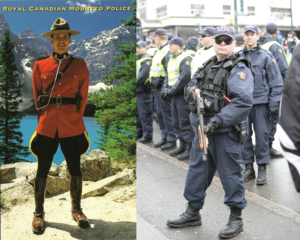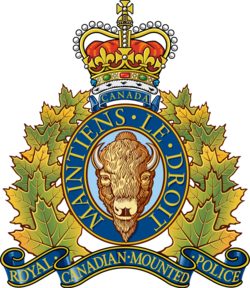Difference between revisions of "RCMP"
(quick expand / PROFUNC) |
m (logo, image) |
||
| Line 3: | Line 3: | ||
|constitutes=Police | |constitutes=Police | ||
|start= | |start= | ||
| + | |image=RCMP.png | ||
| + | |image_caption=RCMP in dress uniform and modern everyday uniform | ||
|headquarters=M. J. Nadon Government of Canada Building 73 Leikin Drive Ottawa, Ontario K1A 0R2 | |headquarters=M. J. Nadon Government of Canada Building 73 Leikin Drive Ottawa, Ontario K1A 0R2 | ||
|type=Dragoons | |type=Dragoons | ||
| + | |logo=Coat of arms of the Royal Canadian Mounted Police.png | ||
|predecessors=Royal Northwest Mounted Police (RNWMP) (1904), North-West Mounted Police, (NWMP) (May 23, 1873), Dominion Police, (1868) | |predecessors=Royal Northwest Mounted Police (RNWMP) (1904), North-West Mounted Police, (NWMP) (May 23, 1873), Dominion Police, (1868) | ||
|abbreviation=RCMP/GRC | |abbreviation=RCMP/GRC | ||
Latest revision as of 02:25, 23 February 2022
(Police) | |
|---|---|
 RCMP in dress uniform and modern everyday uniform | |
 | |
| Abbreviation | RCMP/GRC |
| Motto | Maintiens le droit "Defending the Law" |
| Predecessor | • Royal Northwest Mounted Police (RNWMP) (1904) • North-West Mounted Police • (NWMP) (May 23 • 1873) • Dominion Police • (1868) |
| Headquarters | M. J. Nadon Government of Canada Building 73 Leikin Drive Ottawa, Ontario K1A 0R2 |
| Type | Dragoons |
| Staff | 28,461 |
| The federal and national police service of Canada | |
The Royal Canadian Mounted Police (RCMP) are the federal and national police service of Canada, providing law enforcement at the federal level. The RCMP also provide provincial policing in eight of Canada's provinces (all except Ontario and Quebec) and local policing on a contract basis in the three territories (Northwest Territories, Nunavut, and Yukon) and more than 150 municipalities, 600 Indigenous communities, and three international airports.[1] All members of the RCMP have jurisdiction as a peace officer in all provinces and territories of Canada.[2] Despite the name, the Royal Canadian Mounted Police are no longer an actual mounted police service, with horses only being used at ceremonial events.
The two most populous provinces, Ontario and Quebec, maintain provincial forces: the Ontario Provincial Police and the Sûreté du Québec. The other eight provinces contract policing responsibilities to the RCMP, which provides front-line policing in those provinces under the direction of the provincial governments.
The RCMP is responsible for much of Canada security and policing. Under their federal mandate, the RCMP police throughout Canada, including Ontario and Quebec (albeit on smaller scales there). Federal operations include: enforcing federal laws including commercial crime, counterfeiting, drug trafficking, border integrity (excluding border control responsibilities exercised by the Canada Border Services Agency), organized crime, and other related matters; providing counter-terrorism and domestic security; providing protection services for the Canadian monarch, governor general, prime minister, their families and residences, and other ministers of the Crown, visiting dignitaries, and diplomatic missions; and participating in various international policing efforts.
Instructions from the FBI
Peter Dale Scott writes that "It is not disputed that Ali Mohamed organized the Embassy bombing in Kenya; and that he did so after the RCMP, who had detained him in Vancouver in the presence of another known terrorist, released Mohamed on instructions from the FBI."[3]
PROFUNC
For more than three decades the RCMP ran PROFUNC (PROminent FUNCtionaries of the Communist Party), a highly secretive espionage operation and internment plan.[4]
In case of a “national security” threat up to 16,000 suspected communists and 50,000 sympathizers were to be apprehended and interned in one of eight camps across the country. Initiated by RCMP Commissioner Stuart Taylor Wood in 1950, the plan continued until 1983.[4] In 1984 the Canadian Security Intelligence Service (CSIS) was created to carry out security and intelligence gathering work that had previously been the RCMP’s responsibility.
The plan was highly detailed. Police stations across the country would receive a signal to open their PROFUNC lists and apprehend said individuals. The “communists” would then be taken to “reception centres” where they would be restricted from talking and anyone attempting to flee would be shot.[4]
Thousands of officers collected information for PROFUNC at one time or another. Each potential internee had an arrest document (C-215 form) that was regularly updated with the person’s physical description, age, photos, vehicle information, housing and sometimes the location of doors they might use to escape arrest.[4]